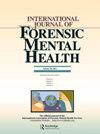Predictive Validity of the HCR-20v3 Compared to the HCR-20v3 with the FAM in Women
IF 0.9
4区 医学
Q3 CRIMINOLOGY & PENOLOGY
International Journal of Forensic Mental Health
Pub Date : 2022-10-07
DOI:10.1080/14999013.2022.2130478
引用次数: 3
Abstract
Abstract Recent findings have highlighted unique risk factors for female-perpetrated violence as well as limitations in its risk assessment. To address these shortcomings, the Female Additional Manual (FAM) was designed as a complementary tool for the gender-neutral framework of the Historical, Clinical, Risk Management-20 (HCR-20). Little research has been undertaken exploring the predictive validity of the FAM, particularly when used with the most recent version of the HCR-20 (HCR-20v3), leaving equivocal evidence in regards of its use in clinical practice. The present study compared the predictive validity of the HCR-20v3 with and without the FAM for inpatient violence. The sample consisted of 42 female forensic psychiatric patients in a low to medium secure unit in the UK. Results revealed a significant difference in the predictive validity of the HCR-20v3 compared to the FAM when assessing for physical violence and no significant differences between the instruments’ validity in predicting nonphysical and any violence. In line with existing literature, the HCR-20v3 was an overall good predictor of violence. While the FAM was less accurate than the HCR-20v3 at predicting physical violence, it achieved moderate to large effect size in predicting each category of violence. The findings provide a degree of support for using the HCR-20v3 when assessing the risk of violence in women but do not demonstrate improved predictive power when adding the FAM.HCR-20v3与FAM在女性中的预测有效性比较
最近的研究结果强调了女性实施暴力的独特风险因素及其风险评估的局限性。为了解决这些缺点,女性附加手册(FAM)被设计为历史、临床、风险管理-20 (HCR-20)中性框架的补充工具。很少有研究探索FAM的预测有效性,特别是当与最新版本的HCR-20 (HCR-20v3)一起使用时,留下了关于其在临床实践中的使用的模棱两可的证据。本研究比较了有和没有FAM的HCR-20v3对住院暴力的预测效度。样本由42名女性法医精神病患者组成,他们住在英国一个低到中等安全的单位。结果显示,在评估肢体暴力时,HCR-20v3的预测效度与FAM相比存在显著差异,而在预测非肢体暴力和任何暴力方面,两种工具的效度之间没有显著差异。与现有文献一致,HCR-20v3总体上是一个很好的暴力预测指标。FAM在预测肢体暴力方面不如HCR-20v3准确,但在预测各类暴力方面达到了中等到较大的效应量。研究结果为在评估妇女暴力风险时使用HCR-20v3提供了一定程度的支持,但在添加FAM时并未显示出更好的预测能力。
本文章由计算机程序翻译,如有差异,请以英文原文为准。
求助全文
约1分钟内获得全文
求助全文

 求助内容:
求助内容: 应助结果提醒方式:
应助结果提醒方式:


